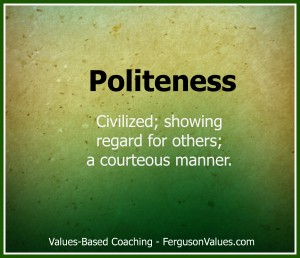How Polite is Your Brand?
The value of politeness means civilized; showing regard for others; a courteous manner.
Marketing Questions:
- If your brand were a person, how would a complete stranger describe it?
- How your employees treat each other is how customers get treated. Do current behaviors align with your brand promise?
- If everyone in your organization said “please” and “thank you”, what impact would that have on your culture and your brand?
Obtaining Permission through Politeness
If your area of focus is in customer service, you might want to read about the value of cordiality. Learning to be polite, warm, and friendly is one of the toughest jobs in any organization. Thankfully there are a few people who really excel in this area.
In the area of brand building, some marketers believe they can’t get consumer attention AND be polite. So they choose to spend lots of money to interrupt our life by placing their messages everywhere, and even scream in our face where they can. This is an ‘old’ marketing paradigm, which most experts agree is dying (or is dead already).
As Seth Godin wrote in his groundbreaking book Permission Marketing (way back in 1999!), the new marketing stops interrupting customers and instead provides something “anticipated, personal, and relevant.” However, marketers have struggled with learning how to obtain permission.
Maybe it’s time to consider earning permission through politeness. This might include:
- Being considerate of your customers’ time and attention.
- Not talking down to customers, rather speaking to them as ladies and gentlemen.
- Showing interest in what customers want to know vs. what you want to tell them.
- Not playing games, rather being open, honest, and transparent with the facts.
- Offering suggestions that are relevant to your customers vs. being self-serving.
Does this mean marketers must respond to every whim and fancy, or do whatever their customers ask? Of course not. However, marketers have a choice to respond with arrogance or politeness. Marketers who embrace the value of politeness remain civilized and courteous. Always.
Does this mean your marketing must be boring? Absolutely not! Many great marketers use appropriate humor that they know will resonate with their target audience. Others use music, or drama, or heart-wrenching emotion to connect with their customers. In marketing communications today, great creativity is appreciated more than ever, which is evident when consumers share advertising and it goes viral.
Two examples of this are: K-Mart’s Ship my pants, and Dove’s Real Beauty Sketches.
Consumers willingly share these brand stories because they connect real people with real life, one with humor and the other with emotion. Both are respectful and civilized (yes, even the K-Mart ad that plays with a naughty phrase). Both honor permission marketing as Godin defined it.
Now the questions for these companies are:
- Do the rest of the marketing touch points align with the brand message portrayed in these videos?
- Is the permission for further dialogue maintained in a courteous manner, in-store, by phone, or on the website?
Politeness may pave the way for permission for further dialogue with customers. But if it’s to have a permanent effect, then it needs to be maintained throughout the entire brand experience. This is why the value of politeness is more of a cultural issue than a marketing tactic. When politeness is part of the fabric of an organization, then obtaining permission from customers will be as simple as saying “please” and “thank you.”
How can the value of politeness help you create competitive advantage?
Today’s value was selected from the “Fairness-Respect” category, based on the e-book Developing Your Differentiating Values.








